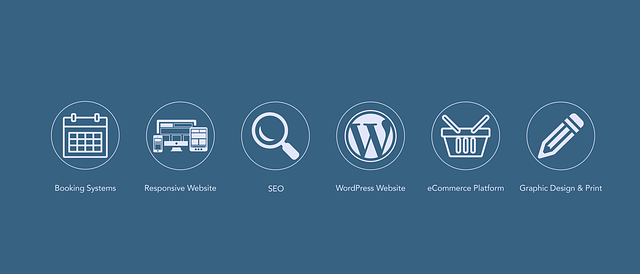Internal Linking with Semantic Anchor Text: A WordPress SEO Guide:
Optimize your WordPress site's SEO and user experience through strategic internal linking using semantic anchor text. This involves creating a network of contextually relevant links that guide users and search engines, enhancing content connections. Utilize tools like Google Search Console and Yoast SEO to audit popular pages, selecting high-quality, theme-relevant content for backlinks. Implement diverse anchor text techniques, including long-tail keywords and semantically related terms, to improve backlink relevance. Diversify further with exact match, partial match, and branded terms for seamless user navigation. Regularly measure performance using Google Search Console and Analytics to fine-tune strategies based on user behavior and SEO rankings.
In the digital landscape, internal linking is a powerful strategy for enhancing website performance. This comprehensive guide optimizes long-form content by unveiling step-by-step strategies for effective internal linking in WordPress. From understanding the foundational role of internal links in SEO to crafting semantic anchor text and identifying relevant content, we provide actionable insights. Learn how to implement strategies that boost user experience while ensuring search engine optimization success. Discover metrics to measure your internal linking performance and elevate your online presence.
- Understanding Internal Linking: The Foundation of SEO
- Semantic Anchor Text: Crafting Meaningful Links
- Identifying Relevant Content for Backlinks
- Implementing Effective Internal Linking Strategies
- Optimizing for User Experience and Search Engines
- Measuring and Analyzing Your Internal Linking Performance
Understanding Internal Linking: The Foundation of SEO

Internal linking is a fundamental strategy for any website aiming to excel in search engine optimization (SEO). At its core, it involves creating a network of links within your content to guide users and search engines through your site’s vast information. This process isn’t just about improving navigation; it’s a powerful SEO tool that can enhance the overall user experience and boost your site’s visibility on search engines like Google.
When implementing internal linking, the use of semantic anchor text becomes crucial, especially for WordPress sites. Semantic anchor text refers to the words or phrases used as links that accurately describe the target content, providing context to both users and search engine crawlers. For instance, instead of using generic links like “click here,” consider using specific terms from your target article, such as “read more about SEO best practices” or “explore our WordPress optimization tutorial.” This semantic anchor text optimization ensures that your internal links are not just clickable but also informative, contributing to a stronger content architecture and better SEO performance.
Semantic Anchor Text: Crafting Meaningful Links

Semantic anchor text plays a crucial role in enhancing the internal linking strategy for any website, especially on platforms like WordPress. When crafting links, it’s essential to go beyond simple keyword-rich phrases and focus on creating meaningful connections between content pieces. This involves using semantic anchor text that accurately reflects the target page’s content, providing a clear context for both users and search engines.
By incorporating relevant keywords and descriptive language in your anchor text, you improve the SEO value of internal links. For instance, instead of generic links like “click here,” consider phrases like “learn more about organic SEO strategies” or “explore our comprehensive WordPress tutorials.” This not only aids search engine crawlers in understanding the link’s purpose but also gives users a better idea of what they can expect to discover when they follow the link. A strategic semantic anchor text tutorial can significantly boost your website’s visibility and user engagement, making it an essential tip for any WordPress SEO strategy.
Identifying Relevant Content for Backlinks

Identifying relevant content for backlinks is a crucial step in any effective internal linking strategy. Start by conducting a thorough audit of your website’s existing content using tools like Google Search Console and Yoast SEO. Look for pages with high traffic and engagement, as these are likely to be the best candidates for backlinking. Additionally, focus on content that aligns with your site’s theme and offers genuine value to readers; this increases the likelihood that other sites will naturally link to it.
When selecting content, consider using semantic anchor text tutorial techniques to ensure your backlinks are both relevant and effective. Incorporate keywords strategically into your anchor text, focusing on long-tail phrases and semantically related terms. For instance, if you’re linking to a post about “WordPress SEO best practices,” use anchor text like “learn more about WordPress SEO” or “explore advanced WordPress optimization techniques.” This semantic anchor text optimization enhances both the relevance of your backlinks and their potential impact on your site’s SEO.
Implementing Effective Internal Linking Strategies

Implementing effective internal linking strategies is crucial for optimizing your website’s structure and enhancing user experience. Start by understanding the purpose of each page and identifying relevant content within your WordPress site. Semantic anchor text, a key component of SEO, plays a vital role here. When creating or editing links, use descriptive and contextually relevant keywords as anchor text. For instance, instead of generic “click here,” opt for phrases like “learn more about organic SEO tips” or “read our comprehensive guide to semantic anchor text optimization.”
This approach not only improves the user experience but also helps search engines understand the relationship between your pages. Diversify your anchor text by using a mix of exact match keywords, partial matches, and branded terms. Ensure that internal links are placed within the context of relevant content, providing users with valuable information and guiding them to related resources seamlessly. Remember, semantic anchor text tips can significantly contribute to your SEO strategy, making your website more accessible and credible in the eyes of search engines.
Optimizing for User Experience and Search Engines

In the digital landscape, optimizing your website for both user experience and search engines is paramount. A well-crafted internal linking strategy leverages semantic anchor text to create a harmonious network that enhances navigation and SEO. For WordPress users, this means strategically using relevant keywords within anchor text to provide context to both visitors and search algorithms.
A semantic anchor text strategy goes beyond simple keyword stuffing. It involves integrating descriptive and thematic phrases that accurately represent the linked content’s value. This approach not only improves user experience by making navigation intuitive but also signals to search engines that your pages are interrelated, fostering better indexing and ranking. A semantic anchor text tutorial can guide you through specific techniques, such as employing compound keywords and using variations of target terms to create a diverse yet effective linking structure.
Measuring and Analyzing Your Internal Linking Performance

Measuring and analyzing your internal linking performance is a crucial step in optimizing your website for long-form content and enhancing its overall search engine optimization (SEO). By employing tools like Google Search Console and Google Analytics, you can gain valuable insights into how users navigate your site. These platforms provide data on click-through rates, time spent on pages, bounce rates, and user paths, all of which offer a comprehensive view of your content’s engagement.
For instance, analyzing anchor text distribution can reveal the effectiveness of your semantic anchor text strategy. Ensuring that internal links utilize relevant, descriptive keywords as anchor text not only improves SEO but also guides users toward related content. Regularly reviewing these metrics allows you to fine-tune your semantic anchor text optimization strategies, ensuring that each link contributes positively to both user experience and search engine rankings.
